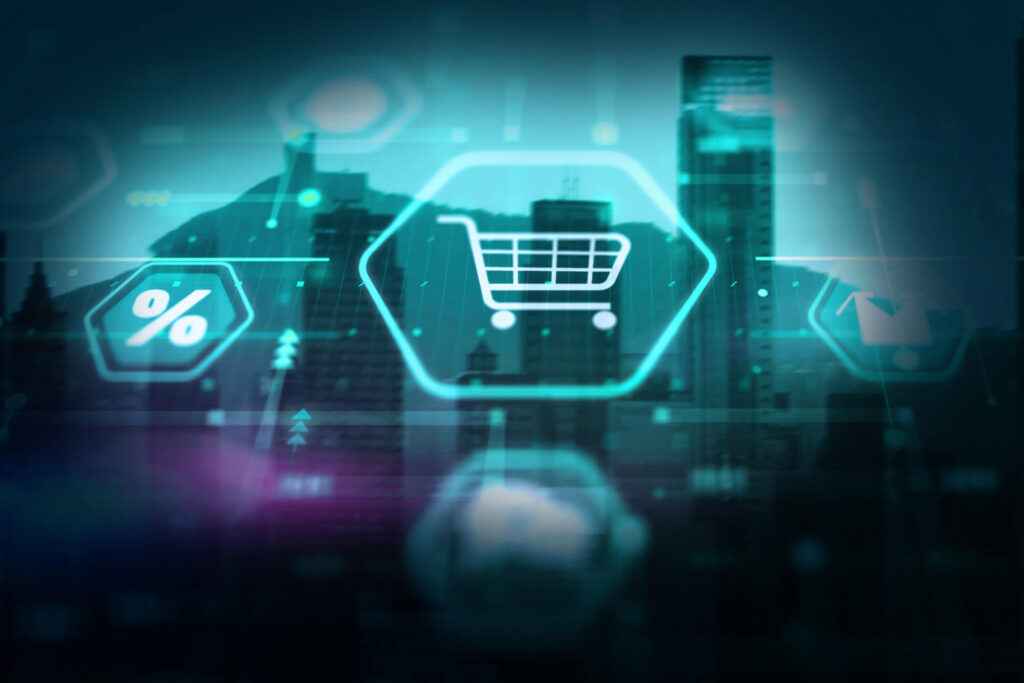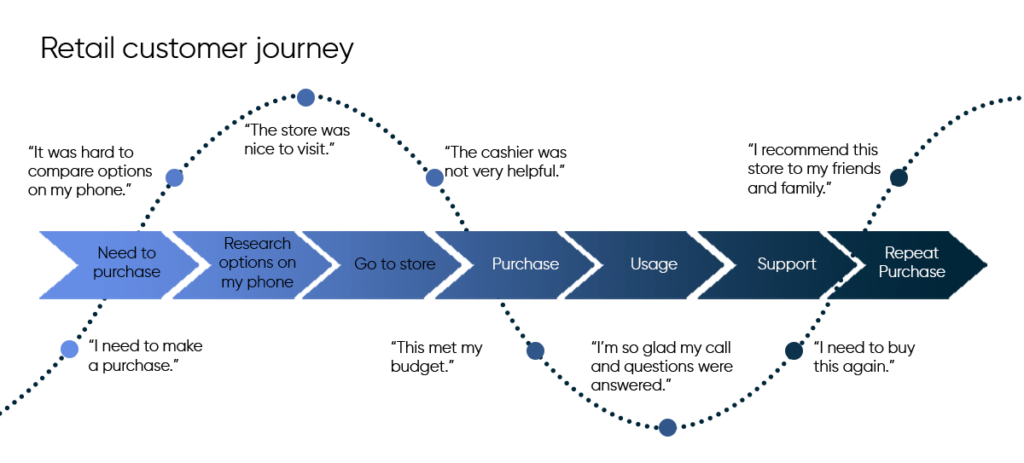
Eight essential scenarios
Retail sales continue their return to pre-pandemic levels, although progress has begun to slow. The largest retailers seek new strategies to prioritize customer experience. Eighty percent of shopping still happens in stores, per an analysis from the National Retail Federation, but customer expectations have changed. Omnichannel service and personalized touchpoints matter more than ever to today’s consumers, and geospatial intelligence is helping retail businesses to deliver.
What is geospatial intelligence?
Geospatial, or location-based marketing technology, utilizes modern connectivity to collect and gather insights from customer location data. Internet of things (IoT) devices, GPS data, and geographic information systems (GIS) all contribute to a holistic picture of consumers’ movements through retail spaces.
What can this data do for you? Marketers and retail business leadership can use geospatial data for:
- Customer insights.
- Market opportunities.
- Strategy forecasting and simulation.
- Traffic pattern analysis.
- Location-based, customized marketing campaigns.
This article will review eight key scenarios in which geospatial intelligence offers significant opportunities for retail businesses.
Also read: Level up your customer experience with franchise technology solutions
1. Location-based audience segmentation
Segmentation groups a company’s market into subdivisions based on shared characteristics, one of which can be geographic location. The categorization can be as granular as is relevant, from nation to region to postal code. While segmenting customers by geographic location provides valuable insights, it can be reductive if used in isolation—particularly when examining densely populated areas.
The capability exists for even more fine-grained geospatial analysis, allowing retailers to analyze customer behavior at the level of a community, a street, or an individual shopfront. The two main marketing technology strategies at this level of detail are geofencing and geotargeting.
- A geofence is a digital cordon surrounding a particular point of interest—a grocery store, for example. Prospective customers can receive relevant marketing materials, promotions, or discount offers inside the geofence boundary (or opt-out).
- Geotargeting takes geofencing a step further, layering customer information such as preferences and history on top of geospatial data. While a geofence might allow a restaurant to target prospective customers within a city, geotargeting would further filter customers based on food preferences—placing promotions in front of the audience most likely to take advantage of them.
2. Density maps and traffic patterns
Modern technology provides robust real-time geospatial information for retailers to analyze. Cameras, IoT sensors, and Wi-Fi connections provide data points allowing businesses to model customer movements within their spaces. GPS data also offers insights into broader activity. Geospatial marketing technology collects and organizes these data streams so retailers can map the density and frequency of foot traffic within specific spaces.
This data helps businesses to:
- Select favorable locations – The neighborhood demographics, surrounding stores, and foot traffic at a particular property can all help a retailer predict the success of a branch in a specific location.
- Analyze internal traffic flow – Customer movement within stores offers insight into audience interests, product popularity, and peak hours.
- Interpret data spatially – See where customers spend the most time and which activations draw the most significant engagement. Shift store layouts and item locations to reduce bottlenecks or promote a new product.
- Fine-tune strategy – Increase interest or boost sales by optimizing displays and planograms for customers’ expectations.
3. Location choice and audience analysis
For retailers seeking the best placement for a new location, geospatial information offers insights into an area’s market potential and demographics. Location-based marketing technology builds on traditional GIS tools by incorporating both detailed on-the-ground information and segmentation data to create maps and visual models, allowing businesses to develop a unified marketing strategy that considers not only an area’s consumer behaviors but the impact of zoning, parking, view corridors, shopping center layouts, and more.
Combined with robust business analytics, geospatial marketing technology allows business managers to optimize their operations and forecast for their unique circumstances.
4. Visualizing the customer journey
While the customer journey is a broader conceptual framework, it also often occurs in a physical space. Mapping that journey as it occurs across a community or within an individual shop can help retailers fine-tune their marketing efforts to their customers’ needs. A visual representation of customer movements enhances staffing and training, guides sales and customer service improvements, and can even provide perspective in broader company presentations.
With a detailed customer journey map, retailers can also align their online and offline marketing campaigns—an essential step toward the omnichannel interactions consumers prefer. An awareness of the intersection of geospatial data with digital channels allows businesses to leverage local SEO, social media, and online advertising to drive foot traffic to local shops.
Offline methods like print advertising, direct mail, and partnerships with neighboring businesses can raise brand awareness among a retailer’s ideal customer segments. These multi-channel methods enhance each other and maximize a company’s returns on its marketing investment.

5. Narrowcasting
Retail businesses can leverage real-time geospatial data to transmit relevant, precisely targeted notifications or special offers when a customer is near a store location or other activation point. Personalized messaging is in demand with consumers, drawing increased engagement and greater sales conversions.
Technologies used in proximity-based marketing include:
- GPS to geofence relevant areas.
- Wi-Fi access points and scanning for data collection.
- Bluetooth beacons for short-range device detection and communication.
- Near-field communication (NFC), the basis for contactless payment and other low-friction interactions.
Proximity marketing technology allows businesses to create customized touchpoints that draw consumers in and drive engagement. Research by the Boston Consulting Group shows that advanced marketing personalization is associated with a 25% increase in revenue for retailers, while the number of customers who are likely to add items to their basket more than doubles when the experience is personalized. This highly specific, location-based marketing technology ensures that carefully crafted messaging reaches the right audience at the right moment.
6. Benchmarking and the competitive landscape
Retailers can better understand their position in the market landscape using data from their stores and also from others in the same industry and physical space. By analyzing competitors’ geospatial data against their own, businesses can forecast the result of strategy changes, set performance benchmarks, and pinpoint development goals.
Businesses often use these standard marketing and customer-experience metrics when benchmarking:
- Social media engagement.
- Brand awareness.
- Customer satisfaction ratings.
- Customer effort score.
- Net promoter score.
- Search engine performance.
- Customer reviews.
- Financial returns.
7. Predictive modeling
Most retailers already use historical data—sales fluctuations, customer engagement, product popularity, and more—to guide future business decisions. Geospatial technologies offer one more valuable data stream that businesses can incorporate into their predictive analytics. Historical location data aids in distributing staff and products efficiently, anticipating changes in demand, and strengthening your supply chain.
Predictive models, however, are only as good as the data that feeds them. Evaluating your data sources for accuracy and running tests and confirmations is critical before relying on analytics-based forecasts.
8. Data security, regulatory compliance, and ethics in marketing technology
Data collection and security questions are becoming increasingly important for consumers and, consequently, retailers. The regulatory landscape on data privacy is complex, with federal requirements intersecting with various provincial statutes. Security strategies will vary based on the specific market, products, and circumstances, but in all cases, protecting private consumer information and meeting regulatory obligations is a priority for retailers.
Those obligations include disclosure considerations and transparency about collecting personal and geospatial information. The advantage, however, is that many consumers are comfortable sharing information with a brand they trust in the service of more personalized interactions.
An expert marketing technology partner will ensure that you meet your data security and compliance obligations, which will help you build the trust you need with your customers to offer them an exceptional experience.
Watch: A sound cloud governance strategy is critical to the success of your cloud transformation strategy
Geospatial intelligence adds a new dimension to market analytics
To keep up with the competition in the modern retail landscape, it is more important than ever to be at the forefront of marketing technology. Finding the expertise, though, can be challenging, particularly when your business focuses on optimizing your operations and creating outstanding customer experiences. That makes it crucial to partner with a technology provider you can trust.
OnX Canada has the depth of experience to help you build the geospatial data solution that fits your retail business. Beyond implementation, OnX can support you with data security strategy, responsive customer support, and even managed services so that you can be confident in the success of your location-based marketing efforts.
















